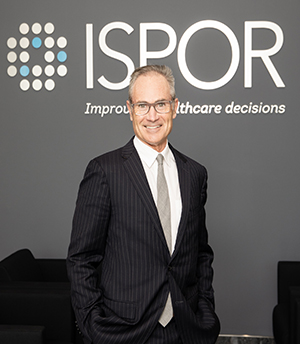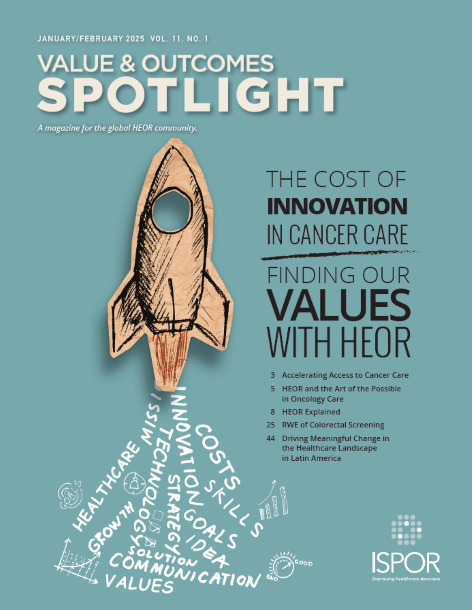HEOR and the Art of the Possible in Oncology Care
Rob Abbott, CEO & Executive Director, ISPOR
 I lost both my parents to cancer. I still remember sitting with my dad in his hospital room, holding his hand as he took his last breath, and helping my mom “die with dignity” at home. Not surprisingly, my interest in the progress of oncology care is both personal and professional. And to be sure, there has been considerable progress in the years since my parents were diagnosed. This is particularly true in the application of health economics and outcomes research (HEOR) to oncology care—the theme of this issue of Value and Outcomes Spotlight.
I lost both my parents to cancer. I still remember sitting with my dad in his hospital room, holding his hand as he took his last breath, and helping my mom “die with dignity” at home. Not surprisingly, my interest in the progress of oncology care is both personal and professional. And to be sure, there has been considerable progress in the years since my parents were diagnosed. This is particularly true in the application of health economics and outcomes research (HEOR) to oncology care—the theme of this issue of Value and Outcomes Spotlight.
As regular readers of Value & Outcomes Spotlight know, HEOR is a multidisciplinary science that is concerned with understanding value in health. In practice, this means closely examining costs and outcomes, as well as factors such as the budget impact of new technologies, patient-reported outcomes, practice patterns, comparative effectiveness, and cost-effectiveness of different healthcare interventions. In view of rapidly rising costs for cancer care, the application of HEOR to oncology becomes increasingly important. As my colleague, Scott Ramsey, MD, PhD, Director of the Hutchinson Institute for Cancer Outcomes Research at Fred Hutch in Seattle puts it: We cannot make good decisions and improve value for patients until cost and quality are taken into account.
There is an underlying concept about value here that I want to emphasize. At ISPOR, when we talk about value, we are intentionally weighing the cost and benefit of various treatments, advocating for the best patient care for the least amount of money. This, in turn, guides us in our ongoing push for evidence-based medicine and cost-containment in healthcare. As ISPOR’s CEO, I’m especially excited about the confluence of medicine and economics. Each informs the other in several important ways. As a professional society—and a society that includes many clinicians—we want patients to get access to treatments that work. And if there are treatments that work equally well, we want patients to get the most cost-effective care. Cancer, in particular, is expensive to treat, as I know first-hand, and many treatments offer patients very little in either survival or quality of life. This is where a more deeply embedded commitment to HEOR can help us make smart choices for patients and be wise stewards of limited healthcare dollars.
"At ISPOR, we know there is still much to be done to improve the application of HEOR to oncology care, especially in the domains of data limitations, training for clinicians and health economists interested in collaboration, and the need for prospective economic study of cancer treatment."
As the papers collected in this issue make clear, HEOR in oncology care centers on the application of health economics theory and models to cancer prevention and screening, diagnosis, treatment, survivorship, and end-of-life care. HEOR in this context is routinely applied to the study of the organization, production, delivery, and demand for cancer-related care, as well as outcomes such as type, quantity, quality, and cost of care faced by the patient, family, payer, and society. Done well, HEOR can have a substantial and positive impact on how cancer care is delivered and how related healthcare policies are developed and implemented. At ISPOR, we know there is still much to be done to improve the application of HEOR to oncology care, especially in the domains of data limitations, training for clinicians and health economists interested in collaboration, and the need for prospective economic study of cancer treatment. I’m personally interested in and committed to improving the availability of key economic measures in data available to researchers; developing standardized methods to measure the cost of cancer care to healthcare systems and patients; and developing mechanisms to support integration of economic analyses alongside clinical trials. This is by no means an exhaustive list of where growth and development are needed, but progress here might help to paint a picture of what is possible when HEOR is applied to oncology care. And it is here that ISPOR has such potential—ours is a big tent and it needs to get even bigger. We need to welcome researchers from multiple disciplines and enhance opportunities for training in economics and in analytic methods from across the social and clinical sciences. This training is a core competency of ISPOR, and I believe we can draw inspiration from research like that reported in this issue and further build out our training efforts to ensure stakeholders throughout the cancer community feel welcome at ISPOR. This, ultimately, is what our vision of healthcare being accessible, effective, efficient, and affordable is all about.

